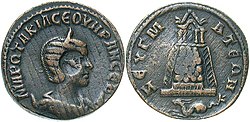Philip the Arab
Philip the Arab (c. 204 – September 249) was Roman emperor from 244 to 249 AD.
| Philip the Arab | |||||||||
|---|---|---|---|---|---|---|---|---|---|
| Roman emperor | |||||||||
 | |||||||||
| Augustus | |||||||||
| early 244 – September/October 249 | |||||||||
| Predecessor | Gordian III | ||||||||
| Successor | Decius | ||||||||
| Co-emperor | |||||||||
| Born | Marcus Julius Philippus c. 204 Philippopolis, Arabia Petraea | ||||||||
| Died | September/October 249 Verona, Italia | ||||||||
| Burial | Unknown | ||||||||
| Spouse | Marcia Otacilia Severa | ||||||||
| Issue | Philip II | ||||||||
| |||||||||
| Father | Julius Marinus | ||||||||
| Religion | Early Christianity (allegedly)[2] | ||||||||
Early life
Philip (Latin: [Marcus Julius Philippus] Error: {{Lang}}: text has italic markup (help))[3] was born in around 204.[4] He got the name "Philip the Arab" (Latin: [Philippus Arabs] Error: {{Lang}}: text has italic markup (help) or Latin: [Marcus Iulius Philippus Arabs] Error: {{Lang}}: text has italic markup (help)).[5][better source needed] (The Chronicon Paschale, a Greek chronicle, and the Latin historian Aurelius Victor each have different dates for Philip's birth.) He was the son of Julius Marinus. Philip was probably born in the city he later named Philippopolis, in the Roman province of Arabia Petraea (now the city of Shahba, Syria).[4]
Emperor
244–245
Philip became emperor at the start of 244. (The Justinianic Code's writing means that Philip became emperor after 13 January 244 and before 14 March the same year.) Philip's wife, Marcia Otacilia Severa, became augusta (empress) early in 244. After Philip became emperor, the Romans and the Sasanian Empire made peace. With this success, Philip got the name Latin: [Persicus maximus] Error: {{Lang}}: text has italic markup (help) (or Latin: [Parthicus maximus] Error: {{Lang}}: text has italic markup (help)) in the middle of 244. Philip came to Rome in 244, probably in early summer.[4]
245–247
In 245, Philip was Roman consul for the first time. That year, the Romans went to war with the Carpi. On 12 November 245, Philip was at Aquae in Dacia (Vidonac, Serbia). Wars against the Carpi and Germanic peoples continued into 247. In 247, Philip was Roman consul for the second time. In late summer 247, Philip held a triumph in Rome. For his military success against the Carpi, Philip probably got the name Latin: [Carpicus maximus] Error: {{Lang}}: text has italic markup (help) at the end of 247.[4]
247–249
In 248, Philip was Roman consul for the third time. In April 248, Philip held a festival for the one thousandth anniversary of Rome, a thousand years since Romulus became the first king of Rome. (The chronicle of the Latin historian Cassiodorus says that this started on 21 April and ended on the 23 April 248.)[4]
John Chrysostom wrote that unlike other pagan rulers of the Romans, Philip was tolerant to the Christians and let them practise their faith openly.[source?] Eusebius wrote Philip and his wife received letters from Origen.[source?]
Death
Some time before 11 September 249, soldiers in the Roman army killed Philip in a battle against the army of Decius. The battle was probably near Verona on the Italian Peninsula. Philip, Philip II, and Marcia Otacilia Severa may all have had damnatio memoriae on them, and the Romans removed their names from some inscriptions.[4]
The Latin historian Eutropius says that Philip and Philip II were both deified (made into gods). This is probably not true.[4] Where Philip's grave was is unknown.[6]
Family
Philip married Marcia Otacilia Severa before 238. At the start of 244, Marcia Otacilia Severa became augusta (empress) and got the Latin title: Latin: [mater castrorum et senatus et patriae] Error: {{Lang}}: text has italic markup (help). Marcia Otacilia Severa probably died in 248.[4]
They had a son, Philip II. The Latin history Epitome de Caesaribus says that Philip II was born in 236 or 237. Only the Greek historian John of Antioch says Philip had other sons. Philip made his son Philip II his caesar (junior emperor) in July or August 244. After July or August 244, Marcia Otacilia Severa also had the title Latin: [mater caesaris] Error: {{Lang}}: text has italic markup (help). In July or August 247, Philip made his son his augustus (co-emperor).[4]
Philip's father, Julius Marinus, died while his son was emperor. After that, people in Philippopolis in Arabia (Philip's home town) worshipped Julius Marinus as a god. However, the Roman Senate probably did not deify Julius Marinus, and he probably did not become one of the official gods.[4]
Philip had a brother, Gaius Julius Priscus. He was a governor of Roman Mesopotamia (Latin: [praefectus Mesopotamiae] Error: {{Lang}}: text has italic markup (help)) and then a praetorian prefect and governor of the East (Latin: [praefectus praetorio et rector Orientis] Error: {{Lang}}: text has italic markup (help)).[4]
Philip The Arab Media
References
- ↑ Cooley, Alison E. (2012). [[[:Template:Googlebooks]] The Cambridge Manual of Latin Epigraphy]. Cambridge University Press. p. 498. ISBN 978-0-521-84026-2.
{{cite book}}: Check|url=value (help) - ↑ McGuckin, John Anthony (15 December 2010). The Encyclopedia of Eastern Orthodox Christianity. John Wiley & Sons. ISBN 978-1-4443-9254-8.
- ↑ In Classical Latin, Philip's name would be written as Latin: [marcvs ivlivs philippvs] Error: {{Lang}}: text has italic markup (help)
- ↑ 4.00 4.01 4.02 4.03 4.04 4.05 4.06 4.07 4.08 4.09 4.10 Kienast, Dietmar; Eck, Werner; Heil, Matthäus (2017) [1990]. "Philippus Arabs (Anfang 244–Sept./Okt. 249)". Römische Kaisertabelle: Grundzüge einer römischen Kaiserchronologie (in Deutsch) (6th ed.). Darmstadt: Wissenschaftliche Buchgesellschaft (WBG). pp. 190–194. ISBN 978-3-534-26724-8.
- ↑ The Latin form "Philippus Arabs" is found in Historia Augusta "The Three Gordians" ch. 29; "Marcus Iulius Philippus Arabs" in Sextus Aurelius Victor, Liber de Caesaribus ch. 28
- ↑ Johnson, Mark Joseph (2009). The Roman Imperial Mausoleum in Late Antiquity. Cambridge: Cambridge University Press. pp. 199–218. ISBN 978-0-521-51371-5. OCLC 309835740.



